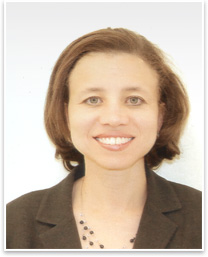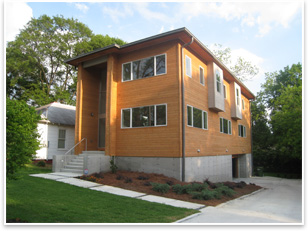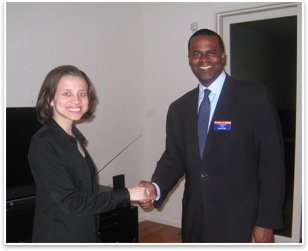 Political Engagement from the Comfort of Home Political Engagement from the Comfort of Home
by Melody Harclerode, AIA, LEED
Summary: Melody Harclerode, AIA, LEED, is a project architect with The Architecture Group in Atlanta, Georgia, who says political engagement doesn’t have to mean deep pockets and expensive dinners. The key is for architects to get involved in a meaningful way in order to keep the profession strong.
The idea of political engagement makes some people roll their eyes with misgivings. Perhaps you picture yourself at a conference center. You have paid for expensive tickets to lobby politicians about important issues as you eat overpriced carrots, celery, and cheese. Perhaps you visualize yourself at a hotel. You have forked out money to chat with strangers while you wistfully desire to have a few moments with the prized politician at the event.
I have participated in those types of events. Most recently, the AIA Georgia hosted a reception for state legislators with two other professional organizations. The occasion allowed architects to learn more about the federal stimulus package, to hear economic predictions, and to lobby state legislators in the Senate to vote against a bill that could weaken the profession of architecture in Georgia. I don’t relish these events, but these forums are necessary forms of political engagement as we architects strive to position our firm, our profession, or even our neighborhood favorably with politicians. However, political engagement doesn’t have to be an expensive or unfriendly process.
 Over the past year, I have organized and hosted meetings between my neighborhood association and the major mayoral candidates in Atlanta, Georgia. My family and I live in Berkeley Park, a neighborhood within walking distance of the hippest burger boutique restaurant in the city; a quirky, little breakfast eatery; an Ace Hardware store; a Kroger grocery store, and several car repair shops. Berkeley Park has something for most people, except residents with deep pockets for politicians. Over the past year, I have organized and hosted meetings between my neighborhood association and the major mayoral candidates in Atlanta, Georgia. My family and I live in Berkeley Park, a neighborhood within walking distance of the hippest burger boutique restaurant in the city; a quirky, little breakfast eatery; an Ace Hardware store; a Kroger grocery store, and several car repair shops. Berkeley Park has something for most people, except residents with deep pockets for politicians.
At a neighborhood meeting last spring, I recommended that Berkeley Park host the mayoral candidates before the election in November 2009. The neighborhood association president, Ron, and other attendees at the meeting strongly supported and approved the proposal. They thought that my home, a modern one designed by me and my husband, also an architect, would be the perfect setting for this event called a Meet and Greet. Ron, also an executive chef at a local country club, volunteered to prepare the food using neighborhood association funds to purchase the food. He would also bring extra chairs from the club to provide additional seating. The local florist would donate flowers for the event.
I first extended an invitation to the incumbent City Council President, a major contender in the mayoral race. I figured that with her name recognition, she would have the biggest draw. I googled the City Council President’s name on the Internet and made a formal request for her to attend the Meet and Greet on her website. Within a few days, a representative from her office called me. We discussed the framework for the event.
I clarified that this get-together was not a fundraiser. Rather, it was an opportunity for the neighborhood to learn more about the candidate’s background, accomplishments, and goals for the city. I would send her representative some questions in advance, so the City Council President would know some of the issues that concerned Berkeley Park residents. Attendees would also have a question and answer session with her. The representative with the City Council President’s office thought these conditions were reasonable and accepted my offer.
 The last hour before the first Meet and Greet passed with lightning speed. About an hour before the start of the event, the florist delivered a stunning bouquet of white lilies. The neighborhood president arrived shortly with wine, bottled water, and exquisite plates of tasty appetizers. Ron, along with my husband, set up the chairs in our family room. To prevent any distractions, my husband left the house with our two children to run errands. In trickles of two or three, Berkeley Park residents came to my house until the number of attendees reached twenty-five (25) people. Soon, the guest of honor arrived and spoke to residents for over an hour. The last hour before the first Meet and Greet passed with lightning speed. About an hour before the start of the event, the florist delivered a stunning bouquet of white lilies. The neighborhood president arrived shortly with wine, bottled water, and exquisite plates of tasty appetizers. Ron, along with my husband, set up the chairs in our family room. To prevent any distractions, my husband left the house with our two children to run errands. In trickles of two or three, Berkeley Park residents came to my house until the number of attendees reached twenty-five (25) people. Soon, the guest of honor arrived and spoke to residents for over an hour.
The Meet and Greet with the Council President was a great accomplishment for my community. In fact, my neighborhood association followed this event with three more Meet and Greet’s involving major Atlanta mayoral candidates. Because of this event, politicians had the chance to visit a small, historic neighborhood, which they would seldom see. The bond within my community strengthened as neighbors socialized together. In addition, residents engaged the mayoral candidates for one to two hours collectively and in one-on-one talks at the conclusion of the event. We learned more about these politicians. They learned more about our concerns, which include police protection and a more judicious use of taxpayer’s money. They also know our expectations if they win the election, one of which was that we want them to return and speak to Berkeley Park residents in a future forum. For my neighborhood, these events are about starting and continuing a relationship with politicians.
The success of the four Meet and Greet events has taught me that I can spend time with politicians in the company of a friendly crowd and at the most comfortable turf for me, my home. I have learned that by engaging politicians before they win office, communities and organizations can have a stronger dialogue with politicians after they win an office. With the help from friends and neighbors, the cost of political engagement can be cheap while the rewards can be priceless. |



